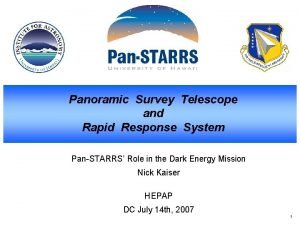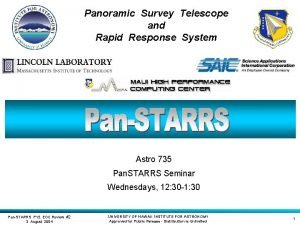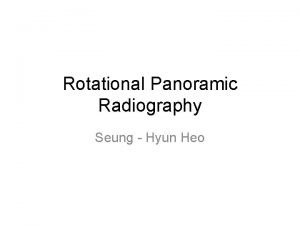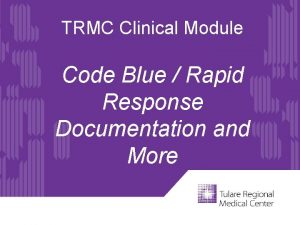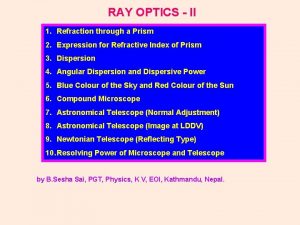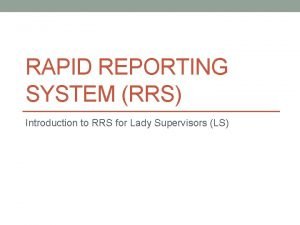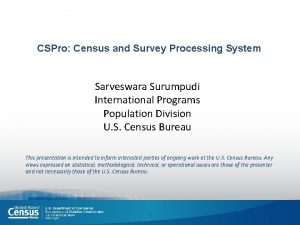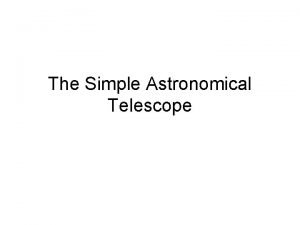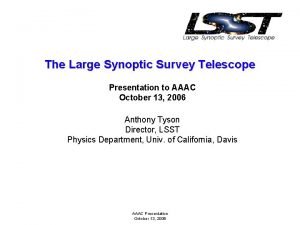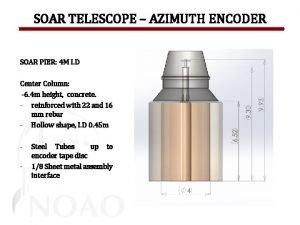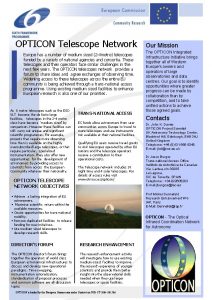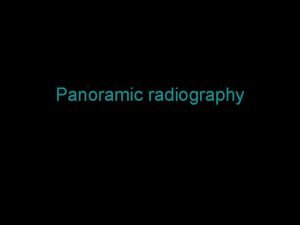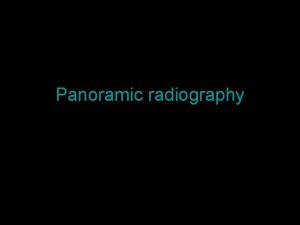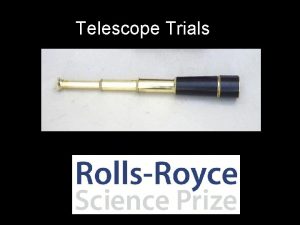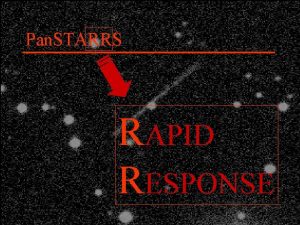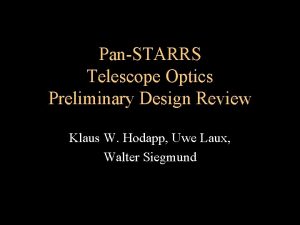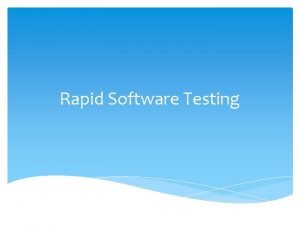Panoramic Survey Telescope and Rapid Response System PanSTARRS


































- Slides: 34

Panoramic Survey Telescope and Rapid Response System Pan-STARRS’ Role in the Dark Energy Mission Nick Kaiser HEPAP DC July 14 th, 2007 1

Outline • Constraining Dark Energy with wide-field optical/NIR photometric survey missions • General requirements for constraining DE from groundbased surveys • Pan-STARRS System Design and Deployment Status • Relation to other proposed experiments • Role of Pan-STARRS in the Dark Energy mission 2

Dark Energy from Wide-Field Surveys • • Goal: determine equation of state w(z) = p / c 2 – DE influences expansion history; geometry; growth of structure – Need to exploit multiple, and complementary, methods Methods/techniques – Weak Lensing (WL) • Primary goal: measure evolution of P(k) with redshift – Also: Geometrical tests – Galaxy-galaxy lensing – BAOs from WL; constraints from shape of P(k) – Galaxy Clustering • Primary goal: Use baryon oscillations (BAOs) as standard ruler – Also: Evolution of P(k), shape of P(k) – Hubble diagram from SN 1 a • Standard candles • Currently provides the best constraints on w(z) but – Reaching limit of statistical (root-N) performance – Follow up requirements for spectroscopy are formidable - need for techniques using only broad-band imaging – Abundance of galaxy clusters • Matched filter (“red sequence”) selection • WL - mass selected samples 3

Requirements • Static sky studies (WL, galaxy clustering) – Precision photometry (for photometric redshifts) – Precision shape measurement (for WL) – Area/depth (cosmic variance) • Transient studies – Precision photometry – PSF modeling – Cadence – Area/depth • (accurate light curves) (for image differencing) (sampling of light curves) (need to reach z~1) Flow down to top-level system design requirements for HW, SW and survey strategy. – Common HW solution is adequate – Much overlap in SW (e. g. image processing pipepine) – Distinct survey strategies 4

Pan-STARRS overview • Pan-STARRS observatory specifications –Four 1. 8 m R-C + corrector – 7 square degree FOV - 1. 4 Gpixel cameras –Sited in Hawaii –A = 50 –R ~ 24 in 30 s integration –-> 7000 square deg/night –All sky + deep field surveys in g, r, I, z, y and w filters • Time domain astronomy – Transient objects – Moving objects – Variable objects • Static sky science – Enabled by stacking repeated scans to form a collection of ultra-deep static sky images 5

PS HW Development/Deployment Schedule • Funded Sept 2002 • Development, infrastructure, and testing (2003 -2005) • PS 1 Integration and Commissioning 2006 -2007 • PS 1 Science Mission 3. 5 yrs (2008. 0 -2011. 5) PS 4 (Development and Construction 2007 -20010) • • • Test Cameras 1 -2 Test Camera 3 360 Mpix • Gigapixel Camera 1 1. 4 Gpix • Gpixel Cameras 2, 3, 4 PS 4 10 yr Mission (2011 – 2021) 6

PS-1 Optical Design - RC + 3 -element wide-field corrector 7

PS 1 Telescope Views 8

SDSS and Pan-STARRS Bandpasses Filters closely matched to SDSS - no U-band, but added Y-band at 1 micron with exceptional quantum efficiency 9

Pan-STARRS Focal Plane • • Optics delivers a 3° field of view to meet science goals. PSF sampling of 0. 26” required to match Mauna Kea seeing. Therefore each focal plane will have 1. 4 billion pixels. Compared to existing cameras, goal was: – 10 x the pixel count – 10 x the readout speed – 0. 1 x the cost per pixel 10

Orthogonal Transfer Array • A new paradigm in large imagers. • Partition a conventional large-area CCD imager into an array of independently addressable CCDs (cells). • Massively parallel design allows rapid read-out -> rapid sky coverage Pixel structure Independently Addressable Cell OTA: 8 x 8 Array of Cells 11

OT Arrays • Orthogonal Transfer Array A new pixel design to noiselessly remove image motion at high speed (~10 usec) Normal guiding (0. 73”) OT tracking (0. 50”) 12

GPC 1 13

Sub-system status Camera: 7 sq deg FOV 14

OTA Quantum Efficiency • OTAs demonstrate expected QE (-65ºC) – 70 um thick devices have exceptional QE at 1 um (Megacam) 15

PS 1 System/Subsystem Overview MOPS 16

Real-Time Image Analysis PS-1 : N sequentially PS-4 : 4 simultaneous raw stacked image The Static Sky static sky image + cleaned stacked image Image Combine & Image Difference difference image 17

Comparison of SDSS photometry with PSPhot R. Lupton (SDSS) has used PSPhot to perform photometry in the galactic plane. Color-magnitude diagram from M 13 are shown (r vs g-r). left: SDSS Photo, right: PSPhot

psastro + pswarp = quality image combinations • Example of pswarp difference image applied to Megacam Taurus images. The relative astrometric solution has a scatter of 6 mas and yields an excellent subtraction.

Pan-STARRS Basic Data Products • Instrumental catalogs - Instrumental magnitudes, coordinates - For precision astrometry/photometry - Postage stamps for bright objects • Cumulative static sky images - Signal + exposure maps - Best + working + compressed intermediate saves • Static sky catalogs - Includes time history of object magnitudes • Difference image detection stream • Recent (~1 month) source and difference images 20

Auxiliary systems & control of systematics • In addition to major system components (telescope-detector-SW), the PS system design features a number of advanced auxilary systems to control, reduce or ameliorate effect of systematic errors. • Implemented features: – Advanced tunable laser system for total system throughput calibration – Wave-front sensing sytems for real-time control of optical alignment and collimation – Imaging sky probe to monitor sky transparency • Planned features: – Atmospheric dispersion compensator (drop in replacement for lens-1) – Spectroscopic sky probe - coupled with MODTRANS atmospheric model to provide accurate correction for sky absorption and subtraction of air-glow 21

Calibration Screen (Chris Stubbs) Screen leaky fibre - monochromatic source tunable from 400 -1000 nm ● measure system throughput ●Combine with spectroscopic sky probe -> synthetic fringe frames ● Advantages ●Repeatability ●Uniformity ●Stability ●Shuttered light source ● 22

Tunable laser (400 nm - 2 microns) Second harmonic (532 nm) generator Mixer (to 355 nm) 1. 064 micron Nd. YAG pulsed pump laser Tunable downconverter 23

Shack-Hartmann Wavefront Sensing • Deployable WFS extends out over focal plane to pick off a star for analysis • Lenslet images and pupil images are parfocal with normal telescope images • out of field of view for normal operations Star beam Cal LED Collimator Beam splitter Lenslets Pupil image SH spots Focal plane 24

Curvature Wavefront Sensing • Curvature sensing design – 2— 4 locations, above focal plane but outside 3 deg FOV – Converging lens and block of calcite • Two images of every star provide above and below focus donuts – Difference is quite sensitive to wavefront aberrations – Operates automatically and continuously with every exposure, no special pointing or overhead. – Results available within 30 sec. 25

Wavefront Sensing • Secondary has x, y, z, tip, tilt • Primary has x, y, z, tip, tilt and 36 actuators along optical axis to correct for gravity and astigmatism Need to correct often to maintain image quality over large field of view • 26

PS 1 Imaging Sky Probe - monitors sky Transparency in real-time large detector (20482) ●back-side illumination ●larger aperture (120 mm) ● 5 filters (grizy) ●Good sampling (5 arcsec) ●controlled focus ●CCD -> OTA TEC package ● Sky. Probe @ CFHT 27

spectroscopic sky probe • • 3 fiber fed spectrographs measure sky emission and stellar continuum 16” telescope ~30 sec exposures targets: F and earlier type stars 9 th magnitude all-sky bright star spectra catalog • Measure low-res sky spectra (sky & stars) Generate high-res model (MODTRAN) Synthesize “fringe frame” • Not currently implemented • 28

Spectroscopic sky probe can provide accurate calibration of absorption of atmposphere and subtraction of air-glow 29

Atmospheric Dispersion Compensator • Siloxane fill view port • Prism rotation motor • M 1 baffle mounting surface • Custom ball bearings M 1 • ADC-L 1 • ADC-P • ADC-L 2 • Cable wrap energy chain • L 2 • L 1 -L 2 rotation motor • Variable strength prism corrects for refractive effect of atmosphere • Drop-in replacement for 1 st element of wide field corrector (L 1) • Not currently implemented for PS 1 30

Relation of Pan-STARRS to other proposed DE missions • Space vs. ground • Ultimately, space-platforms will be needed/preferred • But wide area needed for WL currently only affordable from ground • PS - LSST • Limiting magnitude in ~30 s exposure • PS 1 r~=23 PS 4 r~=24 LSST r~=25 • e. g. number of galaxies ~ 1/flux limit & precision ~ 1/sqrt(N) • SW/data processing requirements are identical • PS 1 development has provided basic image processing system • major input from key LSST scientists • PS 1 has ~200 scientist consortium w. teams tasked to develop science infrastructure SW & refine/debug pipelines • Deployment time-scales and site choices complementarity 31

Funding requirements • Pan-STARRS is critical for attacking the Dark Energy problem: • Order of magnitude increase in performance over state-of-the-art wide field imaging surveys (e. g. SDSS, CFHT/megacam Legacy) • PS 1 starting now - PS 4 could start as soon as 2010 • PS 1 PS 4 PSnn? /LSST? Is a rational progression • Common SW infrastructure needs • limits are from systematic errors - need to learn from experience • PS 4 is funded year-on-year via the AF at the ~$9 M/year level, but • no funds for operation (~$30 M for 10 years of ops) • current funding profile will delay deployment • Accelerated construction to be operational by 2011 requires an injection of ~$20 M (based on PS 1 actual costs) • Highly leveraged investment on AF funding (no commitment to sponsor for scientific deliverables) 32

Pan-STARRS in a Nutshell • Telescopes – Four 1. 8 m R-C + corrector – 7 square degree FOV – Sited in Hawaii – A = 50 – R ~ 24 in 30 s integration • Detector and controllers – 1. 44 x 109 0. 26” pixels per camera – Image motion compensation – 512 channel controller – few second readout – 6 e- read-noise • Operation mode: – Broad band optical imaging – Four telescopes view the same field to detect transient or moving objects and build up a deep image of the sky • Data-Processing System – Multicolor summed images – Difference images for detection of moving and variable objects – Catalogs of static, moving, transient objects • Survey Capability (for Dark Energy): – All-sky (3 pi steradian) to r~26 for WL, BAOs and cluster abundance – Medium & ultra deep surveys for SN 1 a 33

The End 34
 Panoramic survey telescope and rapid response system
Panoramic survey telescope and rapid response system University of hawaii
University of hawaii Hyperparathyroidism panoramic
Hyperparathyroidism panoramic Focal trough in panoramic radiography
Focal trough in panoramic radiography Focal trough dental definition
Focal trough dental definition Surge and rapid response team salary
Surge and rapid response team salary Rapid body survey first aid
Rapid body survey first aid Pediatric rapid response team
Pediatric rapid response team Code blue documentation
Code blue documentation Natural response and forced response
Natural response and forced response What is natural response
What is natural response Primary immune response and secondary immune response
Primary immune response and secondary immune response Abcde acls
Abcde acls Dr smeal
Dr smeal Nlows
Nlows Telescope and microscope
Telescope and microscope Www icds rrs nic in
Www icds rrs nic in Powder based rapid prototyping
Powder based rapid prototyping Polandball
Polandball Rapid recall system
Rapid recall system Liquid based rapid prototyping system
Liquid based rapid prototyping system Nucleated settlement ap human geography
Nucleated settlement ap human geography Census and survey processing system
Census and survey processing system Angular magnification telescope
Angular magnification telescope Monolithic telescope
Monolithic telescope High definition space telescope
High definition space telescope Land based telescope
Land based telescope Pointing model telescope
Pointing model telescope Syntax analysis sentence structure
Syntax analysis sentence structure Syntax analysis sentence structure
Syntax analysis sentence structure The boy saw the man with the telescope
The boy saw the man with the telescope A refracting telescope produces an image using a(n) ____.
A refracting telescope produces an image using a(n) ____. Azimuth encoder
Azimuth encoder Opticon telescope
Opticon telescope Worldwide telescope online
Worldwide telescope online
